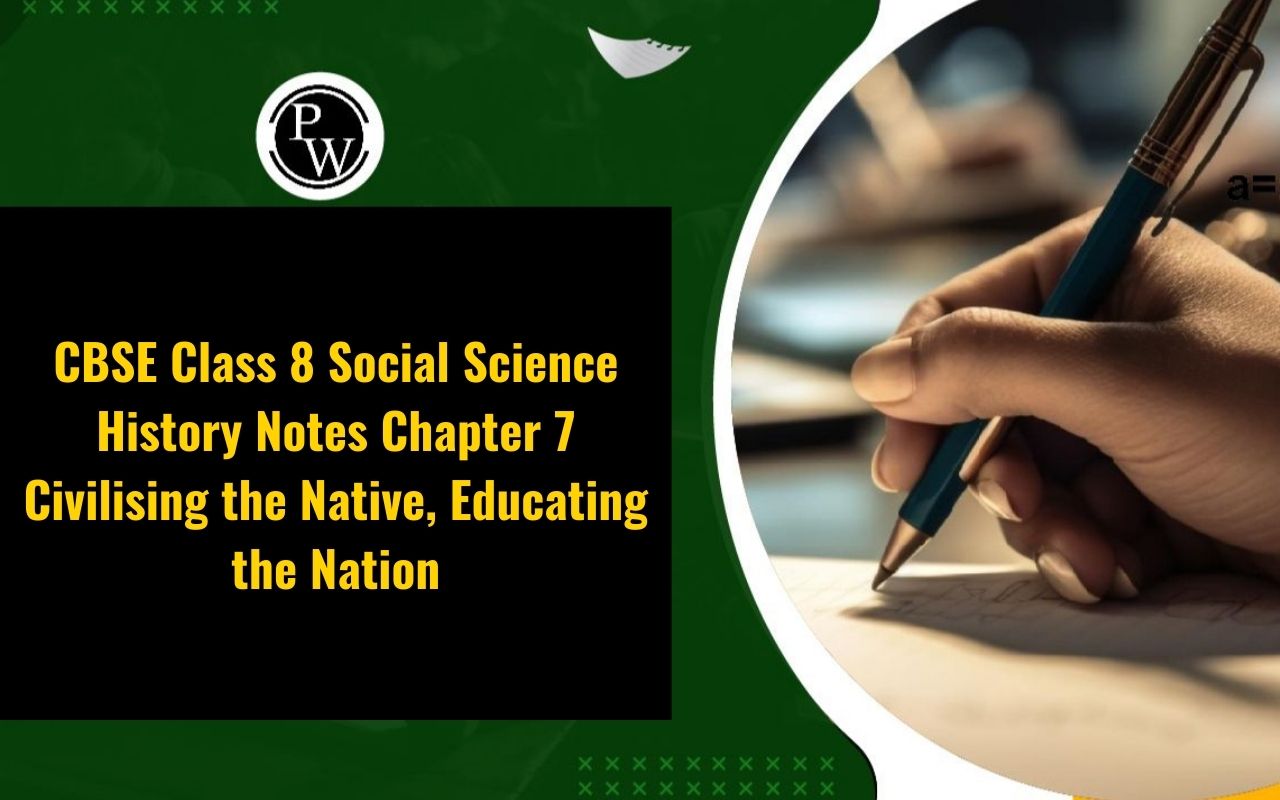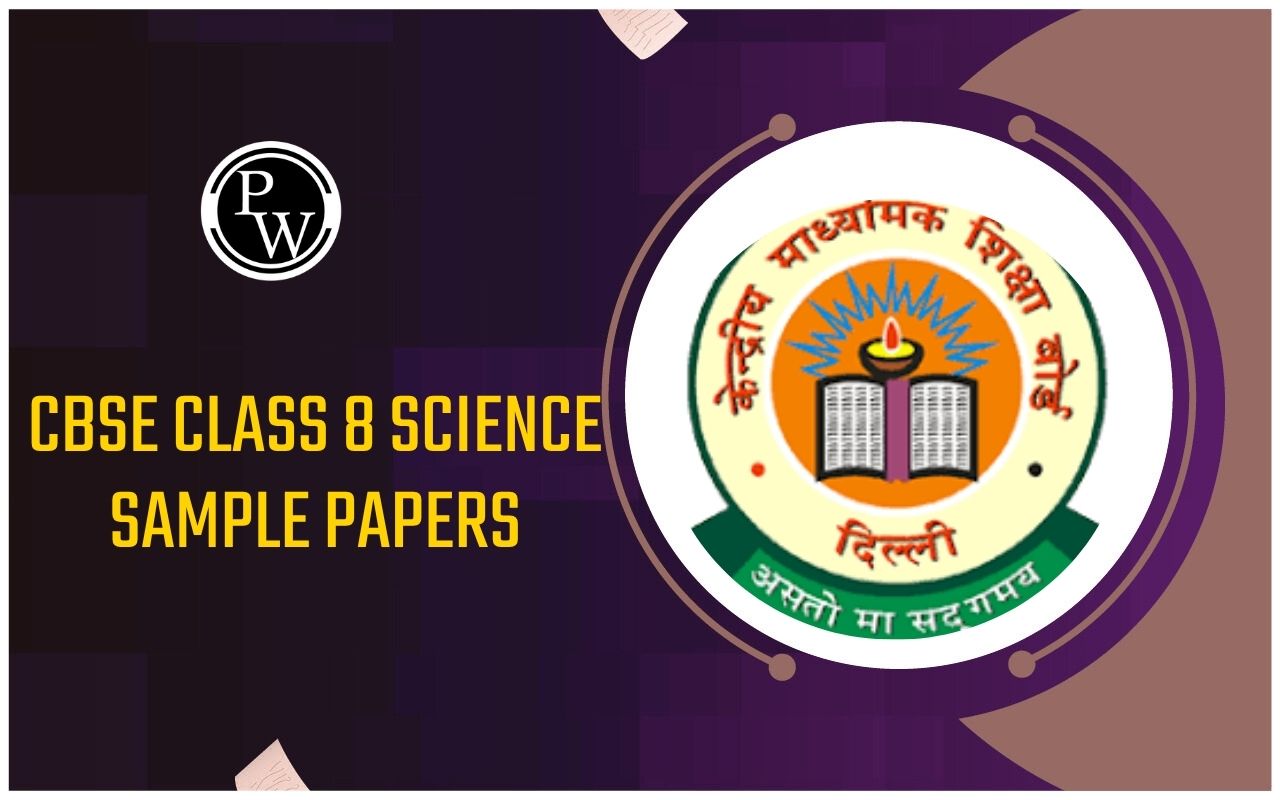

CBSE Class 8 Social Science History Notes Chapter 7: CBSE Class 8 Social Science History Notes for Chapter 7 Civilising the Native, Educating the Nation provide a clear and detailed explanation of British educational reforms in India during the colonial period. The chapter discusses how the British aimed to "civilise" Indian society through education, which often meant imposing Western values and systems on the Indian population.
It highlights key reforms such as the introduction of English as a medium of instruction, the establishment of schools and universities, and the promotion of new educational policies that sought to create a class of educated Indians who could assist in the administration of British rule. The notes also examine the impact of these reforms on Indian society, including the rise of new social and political ideas and the emergence of reformist movements that challenged traditional practices and advocated for educational and social change.CBSE Class 8 Social Science History Notes Chapter 7 Overview
These notes for CBSE Class 8 Social Science History Chapter 7 Civilising the Native, Educating the Nation are prepared by subject experts from Physics Wallah. The notes cover how the British aimed to "civilise" Indian society by introducing Western education and values including the establishment of schools and the promotion of English as the medium of instruction. They also detail the effects of these reforms on Indian society, such as the rise of new social and political ideas and the influence on reformist movements. This expert preparation ensures that students receive a clear and insightful understanding of how education played a important role in shaping colonial and post-colonial India.CBSE Class 8 Social Science History Notes Chapter 7 PDF Download
The PDF link for the CBSE Class 8 Social Science History Notes Chapter 7 Civilising the Native, Educating the Nation is available below. They explain the introduction of Western education, its impact on Indian society, and how these reforms shaped modern education systems.CBSE Class 8 Social Science History Notes Chapter 7 PDF
Quick Revision Notes of CBSE Class 8 Social Science History Chapter 7 Civilising the Native, Educating the Nation
Here, we have provided CBSE Class 8 Social Science History Notes Chapter 7 Civilising the Native, Educating the Nation to help students prepare more effectively for their exams.How the British saw Education
The tradition of Orientalism
In the late 18th century, British officials like William Jones, Henry Thomas Colebrooke, and Nathaniel Halhed became deeply involved in the study of Indian languages and texts, marking the beginning of a tradition known as Orientalism. William Jones, a linguist proficient in multiple languages, including Sanskrit, Arabic, and Persian, arrived in Calcutta in 1783. He, along with Colebrooke and Halhed, established the Asiatic Society of Bengal and launched the journal Asiatick Researches. Their goal was to uncover and translate ancient Indian texts, believing that these texts held the key to understanding India's past glory and aiding in the rediscovery of its heritage. The British officials and scholars felt that by studying and preserving ancient Indian literature, particularly Sanskrit and Persian, they would help Indians reconnect with their rich cultural history. This led to the establishment of institutions such as a madrasa in Calcutta in 1781 to promote Arabic and Islamic studies, and the Hindu College in Benaras in 1791 to encourage the study of Sanskrit texts.“Grave errors of the East”
In the early 19th century, British officials criticized the Orientalist approach to education, labeling it as flawed and unscientific. They argued that Eastern literature was trivial and lacked seriousness. James Mill was a notable critic who believed that education should focus on practical and useful knowledge rather than what he considered the non-essential aspects of Eastern learning. Thomas Babington Macaulay, in particular, viewed India as a land in need of Western civilization. He argued against spending public funds on Oriental studies, deeming them impractical. Instead, Macaulay advocated for the promotion of English, believing it would expose Indians to Western advancements in science, philosophy, and literature. His perspective led to the English Education Act of 1835, which established English as the medium of instruction in higher education and resulted in the production of English textbooks for schools, significantly shaping the educational landscape in India.Education for commerce
In 1854, Charles Wood, the President of the Board of Control of the East India Company, issued Wood’s Despatch to outline a new educational policy for India. This policy emphasized the practical benefits of European learning over traditional Oriental knowledge. According to the Despatch, adopting European education would not only enhance trade and commerce but also develop the country’s resources and improve the moral character of its people. The British believed that European learning would reshape Indian tastes and desires, aligning them more closely with Western ways of life. Following this policy, several significant measures were implemented. The British government established education departments to oversee educational matters and began setting up a system of university education. By 1857, universities were established in Calcutta, Madras, and Bombay. Efforts were made to reform the school education system to align with the new European educational standards.What Happened to the Local Schools?
The report of William Adam
In the 1830s, William Adam was commissioned by the Company to assess the state of education in vernacular schools in Bengal and Bihar. His report revealed a vast network of over 100,000 pathshalas, or local schools, each serving no more than 20 students. These schools, often established by wealthy patrons or the local community, operated with a highly flexible and informal system. They lacked formal infrastructure, such as printed books, dedicated buildings, or standardized facilities like benches and blackboards. Classes were held in various informal settings, including under banyan trees, in village shops, temples, or the homes of teachers (gurus). The educational practices were adaptable to local needs; fees varied based on the family's income, and instruction was tailored to the students' requirements. There were no fixed schedules or formal examinations, and classes were often paused during harvest seasons to accommodate agricultural work. This system reflected a community-oriented approach, catering to the immediate educational and practical needs of the students.New routines, new rules
Following 1854, the British East India Company focused on improving vernacular education by implementing stricter regulations and routines. The Company introduced a structured approach to pathshalas, which included regular inspections and oversight by government-appointed pandits. These pandits were responsible for visiting multiple schools, enhancing teaching standards, and ensuring adherence to new rules. The changes included the use of textbooks, regular timetables, and annual examinations to assess student learning. Pathshalas were required to enforce fixed class schedules, charge consistent fees, and maintain discipline. This shift aimed to standardize education, but it also created challenges. The previous flexibility, which allowed children from poor families to attend school based on their agricultural schedules, was replaced by a system that demanded regular attendance. Consequently, students from poorer backgrounds faced difficulties, as they were now required to attend classes even during critical harvest periods when they needed to work in the fields.The Agenda for a National Education
Before British officials, various Indian thinkers advocated for a broader education system to address the needs of the nation. Many believed that Western education could modernize India and called for the establishment of more schools, colleges, and universities, along with increased funding for education. However, there were also critics of Western education. Prominent figures like Mahatma Gandhi and Rabindranath Tagore expressed concerns about its impact. Gandhi, for instance, was skeptical about Western education's ability to address India's cultural and social needs, while Tagore questioned its suitability for fostering a holistic and meaningful education that aligned with Indian values and traditions.“English education has enslaved us”
Mahatma Gandhi argued that Western education had a detrimental effect on Indian society, creating a sense of inferiority and admiration for British rule among educated Indians. He believed that this education undermined pride in Indian culture and made Indians feel like strangers in their own land. Gandhi saw this as a form of cultural enslavement, which distanced people from their social roots and heritage. He advocated for an education system that would foster dignity, self-respect, and a deeper connection to one's own culture. Gandhi encouraged students to leave British-run institutions to demonstrate their refusal to be subjugated. As nationalist sentiments grew, there was increasing support for developing a national education system that would be radically different from the British model, aiming to empower Indians and restore their cultural pride.Tagore’s “abode of peace”
Rabindranath Tagore established Shantiniketan in 1901 with a vision of an educational environment that was free from the rigid and oppressive structures of British schooling. Having found traditional schools stifling in his own childhood, Tagore wanted a place where children could thrive in a nurturing, creative, and self-directed learning environment. He believed that education should inspire and cultivate a child’s natural curiosity and creativity rather than suppress it. Tagore's approach combined the strengths of modern Western education with the rich traditions of Indian culture. He envisioned Shantiniketan as a "abode of peace," where students could engage with science and technology alongside art, music, and dance, all within a natural setting that encouraged holistic learning. This vision was in contrast to Mahatma Gandhi’s critique of Western civilization’s focus on machines and technology. While Gandhi advocated for a return to simpler, more self-reliant ways of living, Tagore sought to harmonize the best aspects of both Western and Indian traditions in education. The debate among thinkers of the time reflected a broader discourse on how to shape a national education system that truly served India's diverse needs and aspirations.Benefits of CBSE Class 8 Social Science History Notes Chapter 7
- Comprehensive Overview : The notes provide a detailed summary of key events and concepts, offering students a clear and concise understanding of the historical context covered in Chapter 7. This helps in reinforcing their grasp of the material.
- Enhanced Learning Efficiency : By highlighting important points and summarizing complex information, these notes enable students to study more efficiently focusing on critical aspects of the chapter without getting overwhelmed by excessive details.
- Better Exam Preparation : The notes are designed to align with the CBSE curriculum ensuring that students are well-prepared for questions related to the chapter. This targeted approach helps in improving performance in tests and exams.
- Support for Independent Study : The notes are helpful for self-study allowing students to learn at their own pace. They offer a structured framework that supports independent learning outside the classroom.
CBSE Class 8 Social Science History Notes Chapter 7 FAQs
How did British officials criticize the Orientalist approach?
British officials, including James Mill and Thomas Babington Macaulay, criticized the Orientalist approach for being outdated and unscientific. They argued that Western education, focusing on practical and scientific knowledge, was more beneficial for modernization and economic development.
What was the impact of the English Education Act of 1835?
The English Education Act of 1835 established English as the medium of instruction for higher education in India. It led to the development of English textbooks and shifted the focus from traditional Indian education to Western education, aiming to create a class of educated Indians who could assist in administering British rule.
What was the significance of Wood's Despatch of 1854?
Wood's Despatch outlined a new educational policy emphasizing the need for European learning in India. It advocated for the expansion of trade and commerce and the development of resources through Western education. The Despatch led to the establishment of universities in Calcutta, Madras, and Bombay, and set a framework for modern education in India.
How did the local education system change under British rule?
The local education system, which was flexible and adapted to community needs, faced new routines and rules imposed by the British. Schools had to follow a regular timetable, use textbooks, and implement formal examinations. These changes often disrupted traditional practices and made education less accessible for poorer communities.
What were Gandhi's views on Western education?
Mahatma Gandhi criticized Western education for fostering a sense of inferiority and detachment from Indian culture. He believed it led to a loss of pride in Indian heritage and advocated for an education system that would help Indians regain their dignity and self-respect.
What was Rabindranath Tagore's approach to education?
Rabindranath Tagore established Shantiniketan, a school emphasizing creative learning in a natural environment. He sought to blend modern Western knowledge with traditional Indian values, promoting an education system that nurtured creativity and self-exploration rather than rigid discipline.
Talk to a counsellorHave doubts? Our support team will be happy to assist you!

Check out these Related Articles
Free Learning Resources
PW Books
Notes (Class 10-12)
PW Study Materials
Notes (Class 6-9)
Ncert Solutions
Govt Exams
Class 6th to 12th Online Courses
Govt Job Exams Courses
UPSC Coaching
Defence Exam Coaching
Gate Exam Coaching
Other Exams
Know about Physics Wallah
Physics Wallah is an Indian edtech platform that provides accessible & comprehensive learning experiences to students from Class 6th to postgraduate level. We also provide extensive NCERT solutions, sample paper, NEET, JEE Mains, BITSAT previous year papers & more such resources to students. Physics Wallah also caters to over 3.5 million registered students and over 78 lakh+ Youtube subscribers with 4.8 rating on its app.
We Stand Out because
We provide students with intensive courses with India’s qualified & experienced faculties & mentors. PW strives to make the learning experience comprehensive and accessible for students of all sections of society. We believe in empowering every single student who couldn't dream of a good career in engineering and medical field earlier.
Our Key Focus Areas
Physics Wallah's main focus is to make the learning experience as economical as possible for all students. With our affordable courses like Lakshya, Udaan and Arjuna and many others, we have been able to provide a platform for lakhs of aspirants. From providing Chemistry, Maths, Physics formula to giving e-books of eminent authors like RD Sharma, RS Aggarwal and Lakhmir Singh, PW focuses on every single student's need for preparation.
What Makes Us Different
Physics Wallah strives to develop a comprehensive pedagogical structure for students, where they get a state-of-the-art learning experience with study material and resources. Apart from catering students preparing for JEE Mains and NEET, PW also provides study material for each state board like Uttar Pradesh, Bihar, and others
Copyright © 2025 Physicswallah Limited All rights reserved.
Get App










